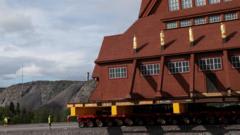The Art of Moving History: Sweden’s Church on Wheels
 The Tech Times
The Tech Times
In an extraordinary feat of engineering and preservation, a Swedish church building recently embarked on an unusual journey—rolling on giant trailers to a new location. This event not only captured the attention of local onlookers but also sparked global curiosity about the logistics and historical significance of such a bold move. As we delve into the details of this remarkable event, we uncover a story that goes beyond mere transportation—it's a testament to human ingenuity, respect for heritage, and adaptability in the face of change.
Engineering Marvel Meets Historical Preservation
The challenge of moving a church is no small undertaking. Churches, often architectural masterpieces, are deeply rooted in their communities both literally and figuratively. Yet, the decision to move a church is not without precedent. The rationale behind such moves typically involves preserving the building from environmental threats, accommodating urban development, or sometimes, the search for a location with greater community access.
In the case of this Swedish church, the move was a calculated effort to preserve a piece of history while adapting to modern needs. The church, originally constructed in the early 1900s, had stood the test of time but faced threats from its geographical location, which was increasingly unsuitable for its preservation. The decision to move it was made with the intent to safeguard its structural integrity and cultural significance for future generations.
Historical Context: A Tradition of Relocation
The relocation of large structures, while rare, is not a modern innovation. Historical records reveal fascinating instances where entire buildings were moved, brick by brick, to new locations. One of the most famous examples is the relocation of the Abu Simbel temples in Egypt during the 1960s. Threatened by the rising waters of the Aswan High Dam, these massive structures were painstakingly relocated to higher ground in a project that demanded international cooperation and technological prowess.
Similarly, in the United States, the story of the Cape Hatteras Lighthouse relocation in 1999 stands out. The lighthouse, an iconic structure on the Outer Banks of North Carolina, was moved to prevent erosion from the encroaching sea—a process that required meticulous planning and execution.
These historical precedents underscore a common theme: the lengths to which societies will go to protect and preserve their cultural heritage. By moving this Swedish church, the community is contributing to this legacy of preservation, ensuring that its historical and architectural value is not only maintained but celebrated in a new setting.
A Testament to Human Ingenuity
The logistics of moving a church involve intricate planning and state-of-the-art technology. Engineers must assess the building’s structural limits, devise a strategy to safely lift and transport it, and ensure it can be reassembled or placed intact at its new location. This process often involves disassembling the structure into manageable segments, using hydraulic lifts and trailers to transport these segments, and employing precise engineering to reassemble them.
For the Swedish church, this process was a grand spectacle. The sight of a historical building traversing the landscape on massive trailers is a powerful image—one that speaks volumes about human creativity, determination, and respect for history. It's a reminder of the possibilities that arise when modern technology is leveraged to preserve the past.
Conclusion: Embracing Change While Preserving the Past
The movement of the Swedish church on giant trailers is more than a logistical triumph; it is a narrative about the careful balance between preserving history and embracing modernity. As our world continues to evolve, such endeavors remind us of the importance of valuing our heritage while adapting to new realities. By moving this church, Sweden not only protects a cherished historical site but also sets an example for communities worldwide—demonstrating that with innovation and respect for the past, we can build a future that honors our history.
As we continue to witness the blending of tradition and innovation, stories like this will remain a testament to our commitment to preserving the cultural tapestries that define our world.
Source: Weekly quiz: Why was a Swedish church moved on giant trailers?
Subscribe to my newsletter
Read articles from The Tech Times directly inside your inbox. Subscribe to the newsletter, and don't miss out.
Written by
